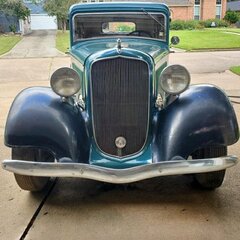Well finally had some extra time and was able to work on the car again. Received a useful father's day gift and wanted to give it a try but first I completed my first dry compression test for the car and myself. I performed the test twice to make sure that I did it correctly and received the same results for both tests.
The results:
#1 - 95
#2 - 92
#3 - 100
#4 - 91
#5 - 90
#6 - 93
I would assume that these numbers are acceptable? Also, cleaned and gapped the plugs while they were out.
Now to play with my gift, a new vacuum gauge!!
As you can see the readings are different with this gauge. I have not changed anything other than gapping plugs and lowering the idle by ear since the last test, so maybe the other gauge caused some fluctuations? The car has a miss in it, so I checked the timing. First, I opened the window on the flywheel once I had it TDC and found no markings. @TodFitch my window is similar to yours but the timings specs are different on the pointer plate, which should be expected since it's a 1934 engine.
I moved on to the crank pulley to look for markings. I figured I would remove the alternator (no generator on this car) to make it easier to hunt for markings. After some scrubbing and sanding, I was able to see markings by the existing white dot.
So to help my old eyes, I added my own markings at every 5 degrees and a line at TDC and 3 degrees after TDC which is the settings for this engine.
After reassembly of everything, I placed the engine on the 3 degree mark, checked the points setting at .020. Started the engine again and the miss is still there. Adjusted the dwell to 36 again and no change. Loosened the distributor and rotated and no major improvements. Rechecked all vacuum connections and no obvious leaks. I went so far as to take the carb off again and check the internals to verify that I reassembled it correctly the last time. Found no issues and after reinstalling the carb, still had the miss. Frustrated by this point, I decided to remove the distributor after setting it to TDC. Once removed, I checked the vacuum advance diaphragm and could not pull a vacuum on it. So there would be one source of a vacuum leak @keithb7and @chrysler1941. Just to mention, I replaced the tubing for the vacuum advance a couple of weeks ago as the other one had some pin holes in it. Also, this engine has a Carter BBR-1 carb with a vacuum port, not original for this year.
So, I will try to find a new vacuum advance or have this one rebuilt. I went through the distributor and cleaned, greased, added new condenser and gave it a new coat of paint. While this is out of the car, what's needed in order to set the dwell on the bench?
Once I have things back together with a new vacuum advance, I'm hoping this corrects the miss!?! What else should I be looking at?


